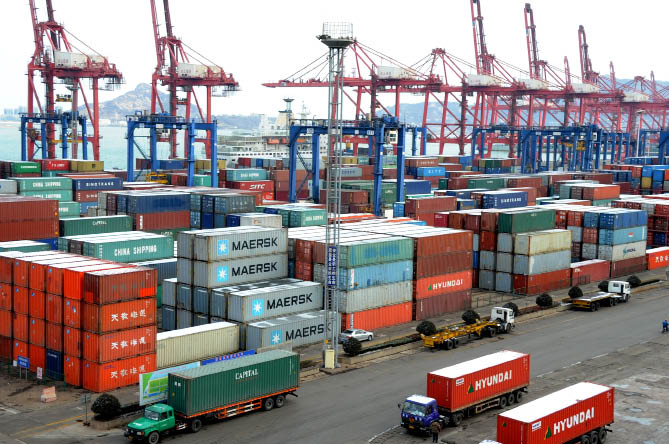| China's Trade Surplus Not Due to Global Economic Imbalance
By ZHAO ZHONGXIU & SUN JINGYING
|
 |
| Bustling Lianyungang Port on China's east coast has a long history of international trade. Photo by China Foto Press |
CHINA'S sustained trade surplus has produced concern in many quarters recently and has triggered calls from some countries, notably the U.S., pressing China to revalue its currency and to rein in policies supportive of its domestic industries. However, analysis shows that China's trade surplus, which has kept increasing for about 20 years, is the result of China's reform and opening-up drive and of introducing preferential policies to attract investment: It has little to do with the RMB exchange rate.
Evolving Towards Basically Balanced Trade
China's trade surplus started getting noticeable in the late 1990s and accelerated rapidly in the 21st century, reaching a peak before the international financial crisis began to impact on trade in 2008. As Figure 1 shows, after 2008 the trade surplus fell somewhat, and the gap narrowed further in 2010.
China's trade surplus in 2010 was US $183.1 billion, a year-on-year drop of 6.61 percent, and the second successive annual fall. The narrowing of the margin was mainly caused by China's dynamic domestic economy as the effects of China's import expansion strategy have become more apparent. With the lifting of processing trade restrictions, which had been imposed to curb exports, imports of processing trade-related bulk raw materials increased correspondingly.
In 2010, China's trade surplus accounted for 3.1 percent of its GDP. Some experts have predicted that the proportion will drop to 1 percent in 2011. We remember vividly that in his letter to the G20 summit last year, Timothy Geithner, U.S. Treasury Secretary, called upon member countries to formulate quantitative targets to improve the current account imbalance and to bring down the proportion of the current account surplus/deficit to GDP to under 4 percent by 2015. Whether China supports this idea or otherwise, judging from the present situation, the drastic decrease in the percentage share of China's trade surplus in its overall GDP will become a trend, indicating a basically balanced development trend in China's foreign trade.
China's import and export trade data for 2010 indicate that the growth mode of China's foreign trade is being transformed and upgraded. In 2010, while processing trade maintained steady growth in imports and exports, there was a rapid increase in general trade imports and exports, replacing processing to account for half of the total trade volume. In terms of export structure, in 2010 China's traditional bulk commodity exports maintained good growth momentum and exports of electromechanical products with high added-value increased by 30.9 percent, accounting for about 60 percent of the gross export value.
In the first six months of 2010, the total value of China's general trade was US $679.49 billion, a leap of 46.5 percent, an increase of 3.4 percentage points over that for overall trade for the same period; the deficit in general trade was US $37.09 billion, in contrast to a surplus in general trade of US $6.35 billion in the first six months of 2009, which indicated that China's foreign trade strategy of adjusting the structure, and improving the balance had achieved a positive result. Since July 15, 2010, China has cancelled tax rebates on 406 tariff items including partial types of steel and non-ferrous metal processing materials, demonstrating the central government's determination to adjust the export structure.
In addition, the proportion of China's trade surplus to the total trade sum decreased from 11.6 percent in 2008 to 8.9 percent in 2009, and it dropped even further to 6.2 percent in 2010. It is predicted that the proportion will continue to decline in 2011, with China's foreign trade becoming more balanced.
As regards the type of commodities, primary products are in deficit on the whole, and manufactured goods are in surplus in general. Of the primary products, food products, live animals for food use, beverages, and tobacco products have a trade surplus, and the rest have a trade deficit. Of the manufactured goods, miscellaneous manufactures, machinery and transport equipment, textile products, rubber products and mining products have a trade surplus. In terms of industrial classification, the vast majority of the trade surplus has been created by communications equipment, computer and other electronic equipment manufacturing, textile and garment, footwear manufacturing, textiles, leather and fur products sectors.
In 2010, clothing, shoes, and luggage products accounted, as they have traditionally done, for an important proportion of all export products. Aside from this, the export value of high-tech products reached US $492.4 billion, representing 31 percent of total exports and displaying the clear effect of favorable policies introduced by the Chinese government in recent years.
|
